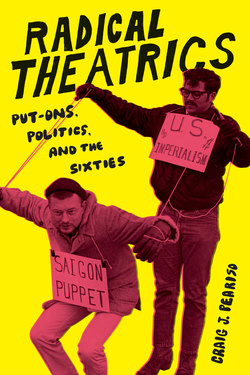Radical Theatrics

Реклама. ООО «ЛитРес», ИНН: 7719571260.
Оглавление
Craig J. Peariso. Radical Theatrics
CONTENTS
Отрывок из книги
RADICAL THEATRICS
PUT-ONS, POLITICS, AND THE SIXTIES
.....
But it was the relation of camp’s practitioners—as opposed to its objects—to another of Baudelaire’s concepts that Sontag found more worrisome. As she understood it, camp amounted to the reformulation of dandyism for the world of mass culture. Its intimate ties to mass culture, however, had effectively expunged the dandy’s “quintessence of character and . . . subtle understanding of the entire moral mechanism of this world.”41 In place of this character and understanding was mere “aestheticism.” Camp’s affected pleasure in the imperfections of the everyday was thus nothing more than the latest moment in the “history of snob taste.”42 More importantly, though, camp had only taken hold at a moment when “no authentic aristocrats in the old sense exist . . . to sponsor special tastes.”43 In the absence of a true upper class “an improvised self-elected class, mainly homosexuals,” had come to serve as the “aristocrats of taste.”44 Camp’s appreciation of the mundane, its celebration of the art of the masses, could never have been mistaken for a truly populist—or even avant-garde—project. Rather, it was precisely the opposite.45 Unlike “true” artists, those who appreciated camp were virtually incapable of developing any deeper understanding of the world. Rather than providing a challenge to critical thought, they had merely inverted its standards.
Once again, though, for Sontag, the most profound challenge to critical thought would proceed through the senses rather than the intellect. It was for this reason, among others, that when faced with camp she experienced a “deep sympathy modified by revulsion.”46 In one sense, the “Camp sensibility” actively thwarted any attempt at easy interpretation—hence her decision to approach the phenomenon through a series of “notes” rather than attempting to fix its meaning in an essay. Yet, at the same time, the paradoxical immediacy of campy objects appeared to hold no social or political promise. To the contrary, camp seemed to render the notion of sensuous immediacy virtually nonsensical. As she observed, “Camp . . . makes no distinction between the unique object and the mass-produced object. Camp transcends the nausea of the replica.”47 Camp’s emphasis on surface and the presentation of self as performance, in other words, was not an attempt to foreground the tensions that might be contained within those surfaces and performances but a clever way of accepting, or even celebrating, them. The camp sensibility delighted in images rather than interrogating them. Her accusation of “aestheticism,” therefore, opposed camp not to reality but to the modernist notion of the work of art as a vehicle for critique.
.....